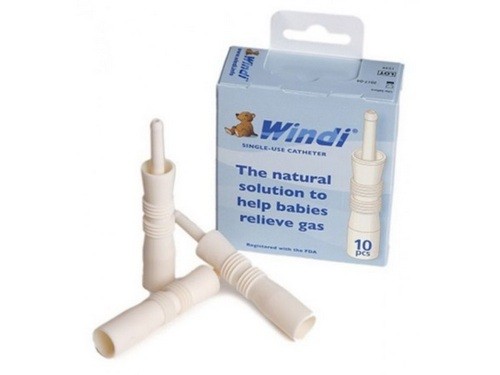All systems of the internal organs of a newborn baby are distinguished by anatomical immaturity. Often, parents are faced with a child’s digestive system, the main manifestations of which are constipation, increased gas formation and, as a result, regurgitation of undigested milk some time after feeding.
The vent pipe for the newborn helps in eliminating such phenomena.
The causes of problems in the lower digestive tract in infants are due to the fact that the microflora present here was not yet fully equipped with the necessary strains of beneficial microorganisms involved in the digestion process. Until this happens, parents will be faced with the periodic occurrence of constipation and flatulence in the baby.
Indications for the use of a vent pipe
As a result of the placement in the rectum of a gas outlet tube for newborns, gases accumulated in the intestine are released, as well as a reflex effect on its walls, which provokes an act of defecation.
However, it is worth noting that the vent pipe for infants is an extreme medical measure that helps alleviate the condition of the baby, and resorting to her help is too often not recommended.

Use a tube to remove gases for infants is necessary only in situations where other methods of eliminating colic are ineffective. The latter include:
- laying out the baby on the stomach;
- circular stroking the child’s tummy clockwise;
- warming the anterior abdominal wall of the infant by applying a heated diaper;
- bending the legs of a small patient in the knees with simultaneous bringing them to the stomach and subsequent extension;
- maintaining the time interval between feedings;
- the use of special medicines belonging to the pharmaceutical group of symbiotics.
Before you purchase and use a tube for the removal of gases for newborns, this issue must be agreed with the pediatrician.
Signs of increased gas formation and violation of bowel movements are:
- absolute absence of stool or its insignificant amount for several days;
- significant excitement of the child, while it is not possible to calm him down by any means (attachment to the chest, motion sickness, use of the nipple and others);
- a change in the coloring of the skin of the face in the baby up to burgundy shades;
- restless movements of the child with legs;
- a complete refusal of the baby to feed, or, conversely, too frequent a requirement to feed him;
- significant tension in the baby of the anterior abdominal wall, an increase in the volume of the abdomen (it becomes like a drum).

When a child manifests such symptoms, a gas vent for infants helps to eliminate pain in him as soon as possible.
Types of tubes
What does this remedy look like and what are its varieties? There are several types of gas outlets that are purchased at the pharmacy:
- Apexmed rectal gas vent tube for newborns. The probe is sterile and designed for single use. It is made of non-toxic materials, which soften when heated in the rectum, which reduces the risk of damage to its mucous membranes. One of the ends of the tube is rounded – this is important, since injury to the intestinal mucosa is prevented when it is introduced. In order to control the depth of introduction of the Apexmed probe, it is marked in the factory (the distance between the marks is 1 cm).
- Windy’s newborn vent pipe is more popular not only among parents, but also among healthcare providers. If it is necessary to use such a tool at home, a rubber gas vent tube for newborns by Windy is its best option, due to the specificity of its shape. Use this type of gas vents without fear of harming the baby can even a person who does not have a medical education. The product is also sterile and is intended for single use.
Other types of tubes produced by other manufacturers (for example, Alfaplastik) serve as variations of the types of venting devices described above. They differ from each other only in color and small changes in design.
The most popular fixture is Windy. Like any other, the Windy handset has pros and cons.
The benefits of a catheter include:
- absolute safety of operation due to the absence of loose parts in the product;
- ease of use (the presence of special notches on the handle prevents the catheter from slipping in the adult’s hand);
- placement of the catheter in the rectum of the child at the required depth.
There are only two negative points: the inability to reuse and the relative high cost in comparison with other types of similar medical devices.

It is also worth mentioning what sizes of gas pipes exist for children. Regardless of the type of product, its diameter is 2-3 mm, and the length does not exceed 22 cm. Immediately after birth and during the first three months, it is necessary to purchase products with the number 16-17.
As the child grows, the product should be purchased in a larger size. In any case, before making a purchase, you need to familiarize yourself with the instructions for use, which describes how to use the vent pipe for newborns.
Rules for the use of gas vents
When it becomes necessary to have rectal catheters, the question arises for parents: how to use this product? For the first time, it will be useful to call a patronage sister who will teach parents how to properly insert a gas outlet to a newborn.
If this is not possible, you should not panic. Each medical device is completed with instructions that describe in detail how to use the vent pipe for newborns.
Instructions for the use of a vent tube for newborns are as follows:
- Check the quality of the product – the catheter should be made of soft, elastic materials that do not cause allergies in children.
- Determine the conformity of product sizes to the baby’s age.
- In the case of reusable flue gas pipes, they should first be boiled for at least 10 minutes and allowed to cool.
- When using disposable sterile products, you must ensure the integrity of the factory packaging.
In the future, in order not to harm the baby, it is necessary to strictly observe the rules governing how to introduce a vent pipe to a newborn:
- On a firm, stable surface where the baby will be laid out, lay a disposable diaper, since fecal matter is released quite often with gases.
- Put the baby on his back, bend his legs in his knees and bring them to his stomach.
- While holding the child’s legs with one hand (if the person performing the procedure is right-handed, the legs should be fixed with the left hand), take the vent pipe in the other hand, placing your fingers closer to its rounded end.
- To facilitate the procedure and reduce the risk of trauma to the mucous membranes of the rectum, it is necessary to pre-lubricate the rounded end of the catheter and the skin of the baby around the anus. How to lubricate the catheter and skin: baby cream, oil or petroleum jelly.
- Further, strictly observing the rules on how to correctly place the vent tube to the newborn, slowly insert the rounded end of the catheter into the anal opening of the baby to a depth of 2 cm in circular motions.
- If the child is excited and crying, as a result of which there is a strong resistance to the introduction of the tube, in no case should you make efforts to overcome it. This is due to a significant risk of damage to the integrity of the walls of the rectum. Without removing the catheter, the child must be distracted, reassured and, when the intestinal walls are relaxed, a vent tube is installed.
- To accelerate the passage of gases accumulated in the intestines, you can hold a light massage of the baby’s front abdominal wall in the form of circular movements in the navel. In order to achieve a reflex response from the side of the intestinal wall, the installed vent tube can be slightly moved.
How much to hold a rectal catheter? It takes 5–10 minutes for the gaziks to move completely. After this, the catheter is carefully removed from the rectum of the child and the baby is washed.

How many times can a flue pipe be inserted? As much as necessary for the complete disappearance of tension of the anterior abdominal wall. After that, the catheter is flushed and discarded if it is a single use. A reusable product is boiling.
According to the rules governing how to put the vent tube to the newborn, the interval between its repeated introduction should be at least 4 hours. This is due to the fact that the baby’s intestinal mucosa is very tender and pressure sores may form on the surface of the rectal catheter under pressure.
If necessary, the artificial removal of gases from the intestines of the baby, parents may have the following questions:
- How often can a gas pipe be placed in a newborn? Is a rectal catheter addictive? The installation of a gas outlet probe is an extreme measure, which can be resorted to no more than 1 time per week, otherwise the child may forget how to recover on their own. If the problem occurs often, the baby must be shown to the pediatrician to exclude serious pathological conditions.
- How to replace a rectal catheter? There is a way how to make a gas outlet to a newborn on his own from a douche or from an enema of the smallest sizes that are purchased in a pharmacy. To do this, the nose of the medical device is neatly trimmed at the expansion site. The introduction of a self-made venting device is carried out according to the same rules as the placement of industrial rectal catheters.
The use of any auxiliary means to eliminate the problem of a swollen tummy in a child is undesirable and is an extreme measure. Do not neglect the preliminary coordination of the issue with the pediatrician, since there are certain pathological conditions in which the use of rectal probes is strictly contraindicated.
The doctor will advise what should be done to prevent the occurrence of colic, taking into account the individual characteristics of a particular baby.



